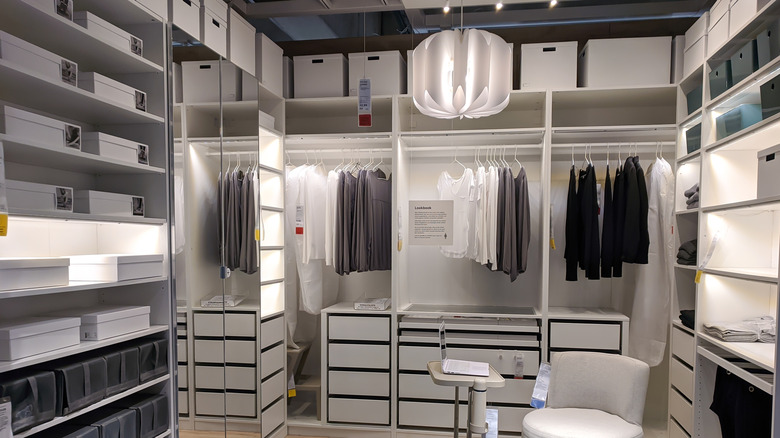Elfa Closet Systems Vs IKEA: Which Is Right For Your Room?
When it comes to taming the chaos in your closet, not all heroes wear capes — some come with assembly instructions and clever storage solutions. If you're eyeing a closet upgrade, chances are you've stumbled upon two leading contenders: Elfa and IKEA. Investing in the right brand will make all the difference, so there's a lot to consider before making a commitment to your closet system. There's plenty of debate over which brand offers the best closet solutions, and the true winner depends on what you value most in your upgrade. Elfa is known for its high-quality, fully customizable closets that are great for those looking for a long-term upgrade, while IKEA's PAX system offers stylish, budget-friendly options with some customization, though they may not be as durable.
Although Elfa offers all the bells and whistles you could want in a closet, those on a tighter budget might wonder if the Elfa is closet system worth it. Meanwhile, those who prioritize affordability but also seek tailored features for their forever closet might question if IKEA is truly up to the task. To find your answer, consider all of the pros and cons of each choice.
Pros and cons of Elfa closet systems
Elfa closet systems are a go-to solution for those looking for personalized storage setup. Sold through the Decor+ Elfa collection at the Container Store, they offer numerous styles from pre-designed spaces and customizable storage with the option for a free design consultation, so you can tailor specifically to your space. Each option is also made with durability in mind, coming with high-quality finishes, soft-drawer slides, and eco-friendly materials, which contribute to the higher cost. You can tweak everything from shelves to drawers and hooks to perfectly suit your storage needs, and there's a 10-year repair or replacement warranty. It's perfect for those wanting a long-term solution, as you can easily adjust the modular setup as your needs change.
However, Elfa might not be for everyone. The cost starts at $228 for smaller, pre-designed components and can go over $5,300 for more comprehensive designs, which can be justifiable as a long-term investment but might not suit every budget. You may be able to strike a deal by following the best sales at The Container Store. The design also uses strong metal materials, and while durable, they may tend to be create some noise when moved around. Another aspect to consider is that the ventilated shelves common in many Elfa systems can allow smaller items to slip through unless paired with shelf liners. Despite these drawbacks, Elfa's quality designs and range of customization can warrant the investment for many shoppers.
Pros and cons of IKEA closet systems
There are a variety of IKEA closet systems to choose from, and their options stand out in affordability for those looking for a budget-friendly solution. Prices range from modest storage accessories starting at $13 to expansive walk-in configurations that can go up to $2,145. Many substantial setups cost less than $600.
IKEA offers plenty of custom accessories to help boost your storage solution with simple and effective details. This includes options for sliding and hinged doors for a clean, minimalist appeal. Customers also love IKEA's online planner for a more personalized approach without the extra expense of a professional consultation. For peace of mind, IKEA backs components of their popular PAX and KOMPLEMENT designs with a 10-year warranty.
That said, there are certain disadvantages to consider. A common issue many encounter is the assembly process, which is notoriously complex and time-consuming, typical of most IKEA furniture. The materials used, such as particleboard and veneer, may not hold up in terms of quality and durability when compared to higher-end systems. While there are numerous customization options, they don't quite reach the extent offered by systems like Elfa, potentially limiting your ability to fully tailor your closet system. Some customers have also pointed out that the finer details, like racks and rods, can feel cheap and perform poorly. These aspects might make IKEA less appealing for those seeking a more durable and refined solution.

